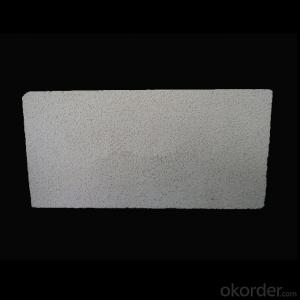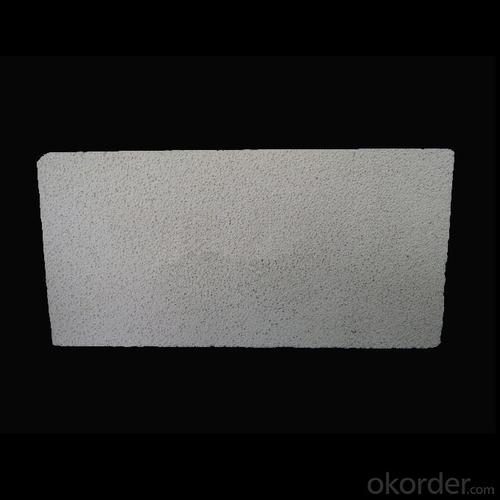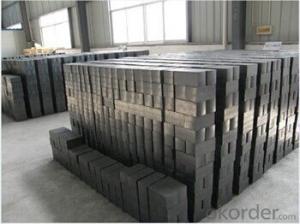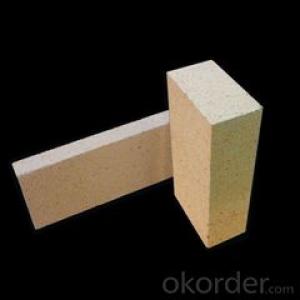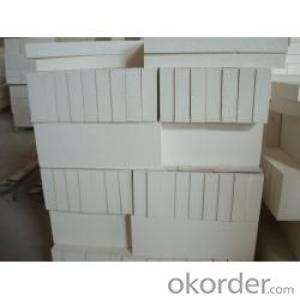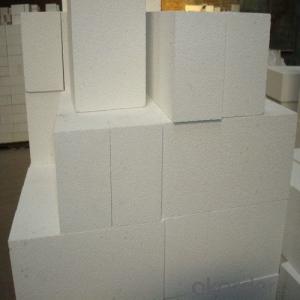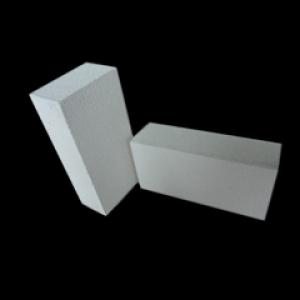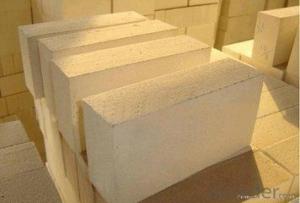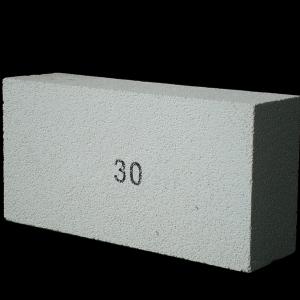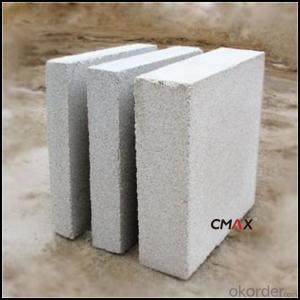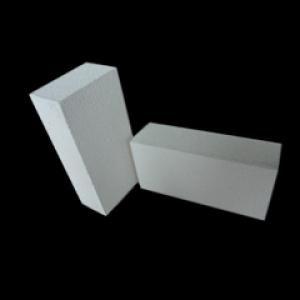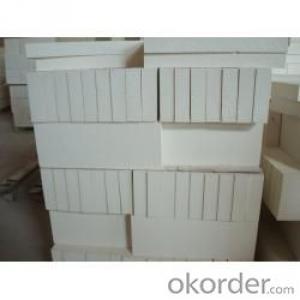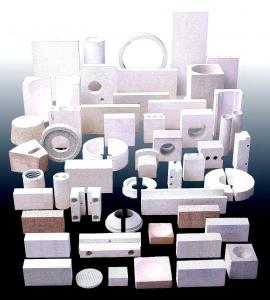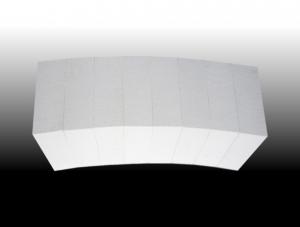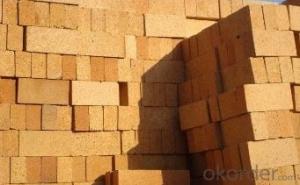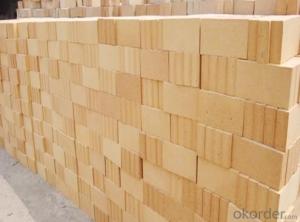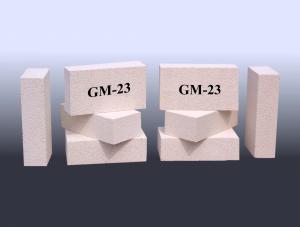High-Quality Insulating Fire Brick
- Loading Port:
- Shanghai
- Payment Terms:
- TT OR LC
- Min Order Qty:
- 10 m.t.
- Supply Capability:
- 100 m.t./month
OKorder Service Pledge
OKorder Financial Service
You Might Also Like
Quick Details
| Place of Origin: | (Mainland) | Shape: | Brick | Material: | Alumina Block |
| SiO2 Content (%): | 55-15% | Al2O3 Content (%): | 35-75% | MgO Content (%): | 0.1% |
| CaO Content (%): | 0.1% | Refractoriness (Degree): | 1770°< Refractoriness< 2000° | CrO Content (%): | 0.1% |
| SiC Content (%): | 0.1% | Model Number: | 230*114*65 | Brand Name: | |
| color: | yellow | Bulk density: | 2.1g/cm3 |
Packaging & Delivery
| Packaging Detail: | wooden pallet packing |
| Delivery Detail: | within 20 days |
Product Description
Refractory brick
1) Good thermal shock resistance
2) High-temperature endurable
3) Good thermal insulation
4)the using tempreture is 1450 C
Physiochemical index
Item | Fireclay brick | High Alumina Brick | ||||
SK32 | SK34 | SK35 | SK36 | SK37 | SK38 | |
Al2O3 (%) ≥ | 35 | 42 | 48 | 55 | 65 | 75 |
Refractoriness (oC) ≥ | 1670 | 1730 | 1750 | 1770 | 1790 | 1790 |
Refractoriness under Load, oC,0.2MPa ≥ | 1250 | 1300 | 1420 | 1470 | 1500 | 1520 |
Linear Change(%),oC×2h | 1350 | 1350 | 1450 | 1500 | 1500 | 1500 |
-0.5~0 | -0.5~0 | -0.4~+0.1 | -0.4~+0.1 | -0.4~+0.1 | -0.4~+0.1 | |
Porosity (%)≤ | 24 | 22 | 20 | 20 | 19 | 19 |
Cold Crushing Strength, MPa≥ | 20 | 30 | 39.2 | 44.1 | 49 | 53.9
|
- Q: Can insulating fire bricks be used in the insulation of walls and roofs?
- No, insulating fire bricks are typically not used in the insulation of walls and roofs. They are primarily designed for high-temperature applications such as lining kilns, furnaces, and fireplaces. Other types of insulation materials such as fiberglass, foam, or cellulose are more commonly used for wall and roof insulation due to their better thermal properties and lower cost.
- Q: Are insulating fire bricks resistant to thermal stress?
- Insulating fire bricks have the ability to resist thermal stress. These bricks are specifically designed to endure high temperatures and fluctuations without cracking or breaking. They are constructed from refractory materials that possess exceptional thermal insulation properties and can tolerate extreme heat. Insulating fire bricks possess a low thermal conductivity, allowing them to effectively resist heat transfer and maintain their structural integrity even when exposed to rapid temperature changes. They find common applications in kilns, furnaces, and fireplaces, where thermal stress is a major concern. In essence, insulating fire bricks are engineered to offer dependable and long-lasting insulation while enduring the thermal stress associated with high-temperature environments.
- Q: Are insulating fire bricks easy to handle and install?
- Insulating fire bricks are generally easy to handle and install. They are lightweight, making them easy to transport and carry around. Additionally, their shape and size are designed to be user-friendly, allowing for easy manipulation and installation. Most insulating fire bricks come with pre-drilled holes or grooves, which further simplifies the installation process. Moreover, these bricks can be easily cut or shaped to fit specific dimensions or requirements, making them highly versatile. Overall, insulating fire bricks are considered easy to handle and install, even for individuals with limited experience or knowledge in masonry work.
- Q: Can insulating fire bricks be used in the construction of steel production furnaces?
- Yes, insulating fire bricks can be used in the construction of steel production furnaces. Insulating fire bricks are specifically designed to withstand high temperatures and provide excellent thermal insulation, making them suitable for use in various industrial applications, including steel production. These bricks are made from lightweight materials that have low thermal conductivity, allowing them to effectively reduce heat loss and improve energy efficiency in furnaces. Additionally, insulating fire bricks have good resistance to thermal shock, which is important in steel production processes that involve rapid heating and cooling. Overall, the use of insulating fire bricks in the construction of steel production furnaces can help optimize performance, reduce energy consumption, and enhance the overall efficiency of the steelmaking process.
- Q: Can insulating fire bricks be used in the construction of lime production molds?
- Yes, insulating fire bricks can be used in the construction of lime production molds. Insulating fire bricks are designed to have high thermal resistance, making them ideal for applications that require insulation and protection from high temperatures. Lime production molds often involve high temperatures during the firing process, and insulating fire bricks can help maintain the desired temperature and prevent heat loss. Additionally, the insulating properties of these bricks can help reduce energy consumption and improve the efficiency of the lime production process. Therefore, using insulating fire bricks in the construction of lime production molds is a suitable choice.
- Q: Can insulating fire bricks be used in the construction of pottery wheels?
- Yes, insulating fire bricks can be used in the construction of pottery wheels. Insulating fire bricks are designed to withstand high temperatures and provide excellent insulation, making them suitable for various applications in the pottery industry. When used in the construction of pottery wheels, these bricks can help to retain heat, allowing for more consistent and controlled firing of pottery. Additionally, their insulating properties can help to minimize heat loss and increase energy efficiency during the pottery wheel's operation. Overall, insulating fire bricks are a popular choice for pottery wheel construction due to their ability to withstand high temperatures and provide insulation, making them a suitable material for this purpose.
- Q: Can insulating fire bricks be used for insulation in oil refineries?
- Yes, insulating fire bricks can be used for insulation in oil refineries. Insulating fire bricks are designed to withstand high temperatures and provide excellent thermal insulation. They are made from lightweight refractory materials that have low thermal conductivity, allowing them to effectively minimize heat transfer. In oil refineries, where high temperatures and heat transfer are common, insulating fire bricks can be used to insulate various components such as furnaces, reactors, and pipelines. By using insulating fire bricks, the heat loss can be significantly reduced, improving energy efficiency and reducing operational costs in oil refineries.
- Q: Can insulating fire bricks be used in space heating applications?
- Indeed, insulating fire bricks can be utilized in space heating scenarios. These bricks possess a design that ensures low thermal conductivity, enabling them to effectively retain and distribute heat within a space heating setup. Crafted from lightweight refractory materials with outstanding insulation properties, these bricks possess the ability to encapsulate heat and prevent its dissipation into the surroundings. Consequently, they prove to be an ideal choice for space heating applications that prioritize energy efficiency. Moreover, insulating fire bricks exhibit a remarkable resilience to high temperatures and thermal shock, rendering them suitable for employment in heating systems that operate at elevated temperatures. All in all, insulating fire bricks emerge as a dependable and efficient alternative for space heating applications.
- Q: Do insulating fire bricks require any curing or drying time before use?
- Yes, insulating fire bricks do require curing or drying time before use. This is because the manufacturing process of these bricks involves the use of binders and additives that need to be cured or dried to ensure proper performance and durability. The curing or drying process allows these materials to harden and solidify, enhancing the insulating properties of the bricks. Failure to properly cure or dry the bricks before use may result in reduced insulation efficiency and potential damage to the bricks during the heating process. It is recommended to follow the manufacturer's instructions regarding the specific curing or drying time required for the insulating fire bricks to ensure optimal performance.
- Q: How do insulating fire bricks affect the overall noise reduction of a structure?
- Insulating fire bricks can significantly contribute to the overall noise reduction of a structure. These bricks have excellent sound-absorbing properties, which help in reducing the transmission of sound waves through the walls or partitions. By effectively dampening and absorbing sound vibrations, insulating fire bricks can minimize the noise pollution within a structure, creating a quieter and more peaceful environment.
Send your message to us
High-Quality Insulating Fire Brick
- Loading Port:
- Shanghai
- Payment Terms:
- TT OR LC
- Min Order Qty:
- 10 m.t.
- Supply Capability:
- 100 m.t./month
OKorder Service Pledge
OKorder Financial Service
Similar products
Hot products
Hot Searches
Related keywords
